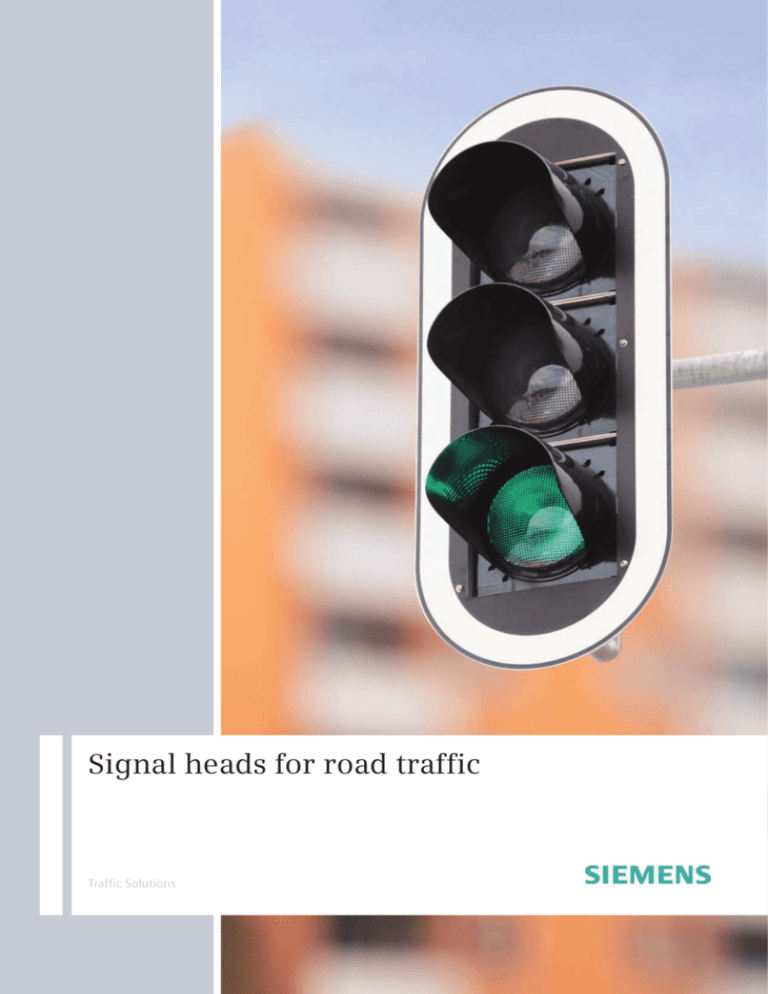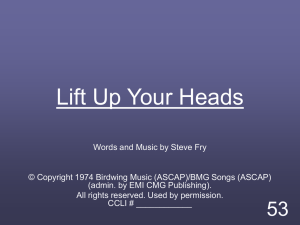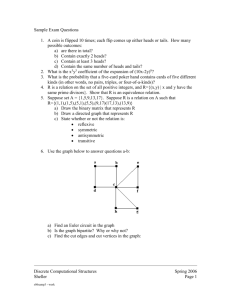
Signal heads for road traffic
Traffic Solutions
Siemens signal heads ... safe,
reliable, environmentally compatible,
energy-saving, attractively priced
LED signal heads
These days, LEDs are the predominant
form of illumination for signal heads,
having largely superseded conventional
signal lamps.
This technology consumes little power,
yet today’s LEDs achieve top traffic signal
performance.
LED signal heads with their bright evenly
illuminated lights are reliably seen by road
users, even in unfavorable lighting conditions, and using LEDs practically eliminates the disorienting phantom reflections that occur when the sun is very low.
The electrical interface to the controller is
provided by a connection enabling
LED signal heads to be operated on
Siemens controllers compliant with
HD 638 / DIN VDE 0832 100.
LED lights have a considerably longer lifetime than conventional signal lamps and
ensure a high level of reliability of the system. Failures caused by defective signal
lamps are a thing of the past.
Conventional signal
heads
Signal heads with conventional signal
lamps are used throughout the world and
can be expanded with a wide selection of
individual parts and accessories.
The product portfolio includes conventional high-voltage signal heads with
230 V signal lamps. Low-voltage technology (10 V) enables your energy consumption to be significantly reduced, right down
to around 20 or 30 W.
PLUS signal heads
The lamp circuits in signal heads with PLUS
technology are switched decentrally in the
signal heads themselves. This provides for
marked reductions in the cabling outlay
and in the work needed to take the units
into operation. PLUS technology is available for 40 V LED and 10 V lamp designs.
The higher efficiency of LEDs means
that their electrical power consumption
is vastly reduced, so running costs for
power supply are correspondingly low.
LED signal heads with their low energy
consumption thus represent a valuable
contribution to environmental protection:
saving up to 90% of the energy consumed
by signal lamps
•
Millions of Siemens signal heads
have proven their value in everyday use.
•
They have demonstrated their
capabilities in many different countries in the most adverse weather
conditions.
•
They blend very well into any
urban situation and have been
awarded with the seal of “Good
Industrial Design”.
Optical aspects and light sources ...
suppression of phantom effects crucial
for good recognition
Visibility
Phantom class
The visibility of traffic signals depends on
the following criteria:
The phantom class describes how well
the equipment suppresses reflections of
sunlight.
•
Luminous intensity distribution
•
Phantom class
•
Evenness of the luminous field
•
Contrast between the signal light and
its surroundings
•
Size of the luminous field
•
Light source
Luminous intensity
distribution
The luminous intensity distribution is
determined by the optical system – i.e.,
by the components that direct the light
(reflector, diffusing lens) and the light
source.
The luminous intensity must be sufficient
to enable the signal to be easily seen in
daylight but not high enough to dazzle
road users at night. And its spatial distribution must ensure that the signal is
recognizable from all relevant positions.
The luminous intensity distribution is specified by DIN EN 12368/ DIN 67527-1. The
distribution for Siemens signal heads with
signal light sizes of 200 mm is based on
the class B2/2, and on class B3/2 for signal
light sizes of 300 mm.
The lights can be dimmed at night for
appropriate markets.
Signal light size
Siemens offers signal light sizes of 200
mm and 300 mm, plus a low level signal
head with a diameter of 100 mm.
The basic design of Siemens signal heads
– i.e., the formation of the light source
and the shape of the optical components
– eliminates most phantom effects.
In the case of conventional signal lamps,
the reflectivity of the optical system can
be further reduced by means of an antiphantom insert.
Phantom effects in LED signal heads are
suppressed almost entirely by inserting
colorless diffusing lenses. Sunlight reflections appear white and are clearly distinguishable from the colored signal light.
LED signal heads achieve the highest
phantom classes, making phantom effects
a thing of the past.
Contrast with the
surroundings
With Siemens signal heads, contrast with
the surroundings is ensured by the dark,
square front surface. This contrast can be
further improved by attaching background
screens, which also serve to make the
signal head more conspicuous to road
users.
Light sources
The predominant light source used today
is LEDs, but various designs of conventional signal lamps are still used in some
cases. The chosen lamps must always be
matched to the optical system in order to
obtain specific luminous intensity values
for specified angles with the lowest possible energy consumption.
Siemens signal heads …
your choice
Signal heads are classified either as LED
signal heads or conventional signal heads.
Siemens offers the following LED signal
heads:
•
Units with 230 V technology
•
Units with 40 V technology
Siemens also offers the following
conventional signal heads:
•
Units with high voltage 230 V
technology
•
Units with low voltage 10 V technology
LED signal heads using 40 V technology and
conventional signal heads with low voltage
10 V technology are also available as PLUS
signal heads.
LED signal heads
LED signal heads have considerable advantages over conventional signal heads and
are used today in practically all new systems.
Thanks to their modular design, existing
systems can be refitted with LED signal head
technology with a minimum of effort.
The benefits of Siemens LED signal heads at
a glance:
•
Brilliant optical properties
•
Colorless lenses eliminate phantom
color effects
•
Phantom class 5 (for almost all colors
and sizes)
•
Energy savings of up to 90% as compared to conventional signal lamps
•
High level of EMC immunity
•
Optimized electrical interface for
SIEMENS controllers
•
Significantly longer life than conventional signal lamps
•
Increased availability of your traffic signal systems
All LED signal heads from Siemens are
equipped with a central light source
comprising one or more high-performance LEDs. The light is refracted by
a Fresnel and diffusing lens to obtain
optimum emission characteristics.
The signals can be easily seen from all
angles and always show an homogeneous illumination.
The luminous intensity has been optimized to achieve a high level of recognition of both signals and symbols
regardless of the environmental conditions. The luminous intensity is more
than adequate, even on bright days,
while at night the symbols are not so
brightly illuminated as to be difficult to
recognize.
Safety technology
To ensure the safety of the traffic
light system, each LED light source is
equipped with an electronic monitoring circuit that has been certified by
the TÜV (the German safety standards
authority). The current and voltage
of the LEDs are continually monitored. If the forced deactivation circuit
registers values indicating that illumination performance conformant to
standards can no longer be assured
the current at the input is interrupted,
thus enabling the controller to detect
the fault in the LED unit.
SILUX LED signal heads with background
screen
SILUX LED insert, view of the inside
Conventional signal
heads
In addition to signal heads with LED light
sources there is a whole range of conventional signal lamps still in use:
•
High-voltage lamps
operating at 230 V that are powered
directly from the public mains supply
•
Low-voltage lamps
operating at 10.5 V that are powered
via a 230 V / 10.5 V transformer
Low-voltage lamps not only have a longer
service life but also offer better light gain
than high-voltage lamps (more lumens
per watt). These smaller light sources also
produce a narrower bundling of the light
distribution. Both effects maximize the
luminous efficacy, leading to a corresponding reduction in energy consumption.
Complete signal heads are available, as
well as upgrade kits for Siemens signal
heads with optical unit diameters of 200
mm and 300 mm.
PLUS signal heads
PLUS signal heads are available as LED
models with either 40 V technology or
conventional 10 V technology.
PLUS signal heads with LED technology
use the same signal heads as for controllers with centralized lamp switches.
A lamp switch module must be installed
in at least one signal head chamber for
each signal pole. The associated transformer can be housed in a pole distributor or in another signal head chamber.
10 V signal lamps are powered by at
least one transformer on each pole,
which means that there is no need for
individual transformers in each signal
head chamber as for conventional 10 V
technology.
PLUS signal heads with conventional
technology have the same optical
system as 10 V signal heads. “Master”
signal heads are responsible for power
supply, lamp control and lamp monitoring, and these may have additional
signal heads attached.
Small signal heads
Small signal heads have a light diameter
of 100 mm and are available either with
LED technology or conventional lamp
technology.
Siemens offers the following versions of
these units:
Small signal head: LED technology
Low voltage signal heads
with 10 V technology
These signal heads are equipped with specially designed reflectors and transformers
that have two pluggable connectors on the
secondary side, enabling them to power
either a 20 W or a 30 W lamp as required.
Failure-monitored lamps in red light units
are equipped with R type ring core transformers complaint with safety regulations; other lights have standard (EI type)
transformers. Both types of transformer
are fitted with interference suppression
elements.
•
LEDs as a 230 V version
•
LED as a 40 V version
•
High-voltage lamps as a 230 V version
•
Low-voltage lamps as a 10 V version
The voltage for low-voltage lamps is generated by transformers in the signal head.
The modular design enables signal heads
to be combined for almost all applications
and all signal colors (red, green, amber,
white and blue) are available.
There has been no compromise with the
functionality of these units – the safety
technology complies with VDE 0832.
Signal head circuit board in PLUS
technology
Material and design ...
decisive for service life,
installation and maintenance
Siemens signal heads are available for
signal light diameters of 200 mm and 300
mm, and these can be combined. Small
signal heads with a signal light diameter of
100 mm are also available.
These signal heads are made of exceptionally tough, solid-colored polycarbonate
with a maintenance-free surface. Tried and
tested high-quality materials are also used
for the other parts.
The design of Siemens signal heads is
appropriate to the materials used and
include many details that add useful benefits. Examples include:
•
Quick-release latch for fast relamping or replacement of the LED insert.
Opening the signal head requires
tools.
•
User-selectable hinge position of the
cover (hinged on the left or right-hand
side); this is important where signal
heads are installed side by side.
•
Terminal block with spring elements
for fast installation plus vibrationresistant contacts.
•
Quick attachment using clamp mounts
without the need to drill holes in the
mast.
•
Visor made of flexible material with
snap-in fastening for easy installation
and replacement.
Terminal block with spring
terminals for rapid, reliable
connection
Signal head quick-release latch
Quick attachment with no need to drill
holes in mast by using clamp mount
(above), protected by the mast cover
Signal head attachment ...
decisive for stability
3
2
1
Cantilever mounting
Attachment using solid support mounts:
1 - Support mount
2 - Fastening part 1
3 - Strap
Installing Siemens signal heads is easy and
saves time.
•
Individual signal heads (light chambers) can be assembled to multi-unit
signal heads without tools, using special lamping rings or collar screws and
nuts. The uniform design of the joints
makes it possible to combine signal
heads of different sizes without any
difficulty. Continuous toothed rings
on the mating surfaces allow adjustment at any angle and reliably protect
against twisting.
•
The following fixing components are
used:
•
Clamp mounts
•
Support mounts
•
Fastening part 1
All mounting elements are made
of corrosion-resistant material and
are essential for secure fastening
with protected wiring. Two different
lengths of clamp mounts and support
mounts make it possible to achieve an
extremely wide variety of signal head
configurations. All tube joints have
uniform threads. Signal heads can be
attached to masts without drilling by
means of stainless steel straps. Corrosion-resistant, rugged and adjustable
special attachments are available for
cantilevers.
•
The entire unit consisting of signal
head, support mount and background
screen is tested in a wind tunnel and
can withstand wind velocities up to
200 km/h.
Toothed ring for secure angular
adjustment
Accessories for signal head installation
Installation on straight Installation on
masts
cantilevers
Universal fastening elements are available
that simultaneously accommodate and
protect the cables. These elements consist
of fastening part 1, which can be screwed
to the signal head, plus tubular clamps and
support mounts. The clamp mount is used
for fast installation of the signal head on
the mast head; installation on continuous
masts and flat surfaces uses the support
mount. The aluminum tubes have a widely
used R 1 ¼» thread size.
The plastic-coated clamp and support
mounts are available in two different
lengths. Their tubes are closed with plastic
sealing plugs during installation.
Installation at mast heads
For mast head installation the signal head
is attached at the upper end of the mast
with a clamp mount; at the bottom it is
supported against the mast by the support
mount. The support mount is fastened to
the mast with a strap. Drilling is unnecessary with this type of attachment as
the cables are routed through the upper
mast opening and the clamp mount, and
threaded holes for fixing screws are not
needed. This ensures efficient installation. The mast opening is closed by a mast
cover that permits adequate ventilation.
The cantilever attachment enables signal
heads (with up to 3 units) to be securely
fastened on cantilevers, as well as on
bridges, portals or walls. Special features
of this fastening method are as follows:
•
Straightforward installation on the
structure
•
When mounted, the ball head and
height-adjustment facility enables
them to be tilted and turned to any
desired angle
•
Secure bolted joints
•
Corrosion resistance
When a 300 mm signal head with
3 units and a type A background screen is
installed, the cantilever attachment can
withstand wind loads of up to 1500 N/m2
(equivalent to a wind speed of approximately 150 km/h).
Installation on continuous mast
Key to figures
1) Threaded bolt
Installation on continuous masts
2) Support mount
For installation on continuous masts the
signal head is attached to the mast by
means of two support mounts.
3) Fastening part 1
In this case, leadthroughs for cables and
threaded holes for fixing screws will need
to be drilled in the mast. For this type of
installation one of the two support mounts
can also be fastened using straps, thus
eliminating the need to drill the corresponding threaded holes.
4) Strap
5) Signal head
6) Mast cover
7) Clamp support
Installation at mast head
A comprehensive product range ...
Vital for universal application
Combining the individual features and
components listed below produces a
broad range of different versions. Further
variants are also available on request.
LED signal heads are protected against
both dust and water jets (from any direction) in accordance with protection class
IP 65.
Conventional high-voltage, low-voltage
and PLUS signal heads are splashproof in
accordance with protection class IP 54.
Models with extra seals and IP 55 protection are also available.
This makes the signal heads suitable for
cleaning with high-pressure water jet
equipment (as frequently used in tunnels,
for example).
Housing
All housing components can be used for
both conventional signal heads and for
LED technology. Complete signal head and
retrofit kits are available.
Housing colors, main
models
Tray/cover combination with visor
Housing colors:
•
Pebble gray/black
•
Pine green/pine green
•
Black/black
Signal light sizes:
•
200 mm and 300 mm diameters
•
100 mm diameter for small signal
heads
Reflectors
For conventional signal heads only:
•
Single reflector
•
Double reflector for installing two
lamps
Lamp bases
For conventional signal heads only:
•
E 27 for high-voltage lamps
(110 V – 240 V)
•
BA 20s for low-voltage lamps (10 V)
and for BÜSTRA 24 V
•
Special bases for special applications
are available on request
Diffusing lens colors
•
Red, amber, green, white
Symbols
When symbols are required, masks are
inserted in the relevant signal fields or
diffusing lenses with burned-in symbols
are used.
In the case of signal heads using LEDs, all
symbols are implemented as masks that
are inserted in the removable front lens in
the LED.
The diffusing lenses for LED signal heads
are made of system-specific colorless or
colored plastic.
Diffuser masks are used to reduce the
luminous intensity of white signals in LED
signal heads (as used in local public traffic
systems, for example) to prevent dazzling
and increase the recognizability of the
symbols.
Symbol lenses are supplied in place of
symbol masks for small signal heads with
LEDs with a light diameter of 100 mm.
To minimize servicing, the LED inserts are
designed in such a way that the symbols
can be changed or rotated on site.
SILUX LED signal head with diffusing lens, symbol mask and optical lens
(from left to right)
Background screens
Background screens are optical aids. By
enlarging the contrast surface and increasing the visibility, background screens
make signal heads much more conspicuous during the day and against bright
backgrounds. Siemens background screens
are manufactured from polycarbonate or
aluminum. Their surface is maintenancefree, and they are strong enough to withstand even high wind speeds.
Background screens are easily attached to
signal heads without the need for drilling.
Background screens in accordance with DIN EN 12368
200 mm signal
light diameter
Type C
300 mm signal
light diameter
Type A
Special shapes
Type C1
300 mm signal
light diameter
10
Type B1
Other versions available on request
Type P
Type Q
Type B
Type E
Type D
Signal head construction with conventional
lamp technology
.
2.
3.
4.
5a
5b
6.
7.
8.
9.
0.
.
2.
Mast cover
Clamp mount
Tray
Spring terminal
Reflector for 230 V
Reflector for 10 V
Lamp
Anti-phantom insert
Seal (cover)
Cover
Seal (diffusing lens)
Diffusing lens
Visor
3. Socket for E 27 base
4. Fastening part 1 (also used for mast
head installation)
15. Collar screw and nut
6. Clamping ring
17. Support mount
8. Plug
9. Strap
20. R type transformer (10 V)
2. EI type transformer (10 V)
22. Socket for BA 20s or 20d base
23. Tray base (for single-unit signal heads)
24. Clamping ring with screw (for
fastening the E 27 base)
11
Signal heads – Dimensions and fastening elements
200 mm signal heads
300 mm signal heads
Clamp mount;
* Short version ** Long version
Dimensions of 200 mm and 300 mm signal heads
Key:
Dimensions in brackets: Signal head with
300 mm signal light diameter
* with short clamp or support mount
** with long clamp or support mount
1) Mast cover
2) Clamp mount
12
3) Fastening part 1
4) Strapt
5) Support mount
Strap; dimension a: 35 - 200 mm, type-dependent
Support mount
* Short version ** Long version
Cantilever attachment
Key:
1) Cable
2) Signal head attachment
3) Strap
4) Cantilever
5) Adjustable
* for 300 mm signal head with 3 signal fields
13
Technical data
Optical properties of the LED signal heads
in accordance with DIN EN 12368 / DIN 67527-1
200 mm diameter
300 mm diameter
Luminous intensity distribution
class
Axial light intensity– typical value
- red
B2/2
B3/2
> 200 cd
> 400 cd
- amber
> 200 cd
> 400 cd
- green
> 200 cd
W (wide-angle signals)
> 400 cd
N (narrow-angle signals)
1:10
1:15
Radiation characteristics
Evenness of the luminous density
Chrominance in accordance with
DIN EN 12368
- red
613 - 631 nm
- amber
585 - 597 nm
- green
489 - 508 nm
S1
Symbol class
4 bis 5
Phantom class
Electrical and mechanical properties of LED signal heads
Operating voltage
Power consumption
(average values; other models
are available for 230 V LED signal
heads)
40 V LED signal head
230 V LED signal head
40V / 50 Hz
230V / 50 Hz
7 W for all colors
red: 17 W
amber: 12 W
green: 12 W
EMC
in accordance with DIN EN 50293
IP 65
Protection type
Diffusing lens
System-specific colorless
plastic lenses
System-specific colored or colorless plastic lenses
Symbol masks
Standard version
(symbol lenses for
small signal heads)
Standard version
(symbol lenses for
small signal heads)
Impact resistance
Operating temperature
Relative humidity
14
white: 12 W
0.9
Power factor
IR 3
- 40° C to + 65° C, class A, B, C
20% to 95%
Signal heads for low-voltage and high-voltage lamps
Mechanical requirements according to DIN EN 12368
Protection • Standard version
• IP 54
type
• Special version available
• IP 55
on request
Bases
• E27 base for lamps (110 V to 240 V)
• BA 20s base for low-voltage high pressure lamps (10 V)
• BA 20s base for low-voltage halogen lamps (10 V)
• BA 20d base for 40 V lamps – available on request
• Bases for special applications – available on request
Optical
system
Symbols
• Reflector: Surface made of high-gloss aluminum
• Diffusing lenses made of polycarbonate with web structure for high-voltage
and low-voltage technology; red, amber, green, white
• Standard symbol masks available on request – symbol lenses
• Symbol classes in accordance with DIN EN 12368: classes S1 and S2
Luminous intensity – dependent on the number of lamps
• Signal size 200 mm:
• Signal size 300 mm:
• Phantom light class:
•
•
•
•
• Background screens:
• Sizes 200 and 300 in accordance with
DIN EN 12368
RiLSA
Type:
B1/2 (min. = 100 cd) or B2/2 (min. = 200 cd)
B2/2 (min. = 200 cd) or B3/2 (min. = 400 cd)
At least class 3 for high-voltage technology
At least class 4 for low-voltage technology
Siemens signal head housings
Material
Tray and cover made of UV-stabilized polycarbonate
Housing colors
• Black,
RAL 9005
• Pine green, RAL 6009
• Pebble gray, RAL 7032
15
16
Further information can be obtained from:
Siemens AG
Industry Sector
Mobility Division
Traffic Solutions
Hofmannstr. 51
D-81359 Munich
The information in this brochure contains
merely general descriptions and service characteristics which in a specific case may not
always apply in the form described, which may
change as a result of further development of
the products. The desired service characteristics shall be binding only if expressly agreed
at the time of entering into the contract.
Order no.: A24705-X-A532-*-7604
Siemens Aktiengesellschaft
© Siemens AG 2008
All Rights Reserved.
SILUX is a registered trademark of Siemens AG.
www.siemens.de/traffic









